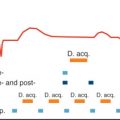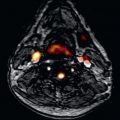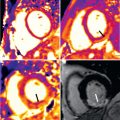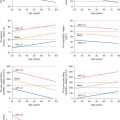Eyes do not see what the mind does not know (Anonymous).
Cardiovascular magnetic resonance (CMR) has been increasingly incorporated into clinical practice as a noninvasive method that offers superior structural and functional assessment of the heart, especially in patients presenting with complex cardiac pathology, congenital cardiac diseases and cardiomyopathies. Because CMR is a cross-sectional modality, it provides complementary information on noncardiac structures adjacent to the heart, including the mediastinum, lungs, chest wall, and upper abdomen. The acquisition of imaging field data outside the heart offers the opportunity for detection of these noncardiac findings.
Indications for CMR: The American College of Cardiology Foundation has listed many conditions considered appropriate for CMR. The major indications include the following:
- 1.
Assessment of right ventricular (RV) and left ventricular (LV) systolic function in cases of:
- •
Cardiac failure
- •
Arrhythmias
- •
Pulmonary hypertension
- •
Cardiomyopathy
- •
- 2.
Assessment of myocardial perfusion:
- •
Ischemic heart diseases (angina)
- •
- 3.
Evaluation of cardiac blood flow in the following conditions:
- •
Valvular heart diseases, for example, aortic regurgitation, mitral regurgitation, aortic stenosis, mitral and so on
- •
Shunts: atrial septal defect, ventricular septal defect, patent ductus arteriosus and so on
- •
- 4.
Inflammatory/neoplastic conditions:
- •
Pericarditis: constrictive, serous, inflammatory and so on
- •
Cardiac tumors; myxoma, rhabdosarcoma, carcinoids and so on
- •
Thrombus
- •
- 5.
Congenital cardiac diseases
- 6.
Coronary artery imaging
- 7.
Assessment of myocardial viability:
- •
After myocardial infarction
- •
An in-depth knowledge of entities affecting different organs in the field of view and a keen eye to detect these noncardiac findings can lead to the reduction in morbidity, mortality in certain cases, and can also add up to screening value. In certain cases the detection and characterization of these noncardiac findings can pose a challenge to the interpreting medical personnel who are reviewing and reporting these studies.
What Is an Incidental Noncardiac Finding?
Incidental findings are defined as the previously undiagnosed medical conditions that are discovered unintentionally and may be unrelated to the current medical condition which is being investigated or for which tests were being performed.
Location of the noncardiac incidental findings: in case of CMR, the organs or systems in which incidental findings may be identified include:
- •
Liver and gall bladder
- •
Kidneys and adrenal glands
- •
Spleen
- •
Peritoneum
- •
Lungs and pleura
- •
Breast
- •
Thyroid, esophagus, and vasculature
- •
Bones; involving ribs, vertebrae, and sternum
Classification of Incidental Noncardiac Findings Based on Clinical Significance
The incidental findings encountered during CMR can be broadly divided into the following categories:
- 1.
Clinically important incidental noncardiac findings: comprise findings that require further clinical or radiological workup and/or an intervention. Not effectively doing so in a timely manner can have negative consequences for the patient. Examples include:
- •
Pulmonary nodules
- •
Solid/complex lesions of solid abdominal viscera
- •
Malignant breast lumps
- •
Esophageal cancers
- •
Thyroid masses
- •
Aortic pathology including aneurysms or dissection, to name a few
- •
- 2.
Moderately important incidental findings: include the findings that may or may not have an effect on patient care depending on medical history or symptomology. In other words, mortality and morbidity is not directly related to the prompt diagnosis and addressing of these findings. Examples include, but are not limited to, the following:
- •
Liver adenoma or focal nodular hyperplasia
- •
Complex renal and adrenal lesions
- •
Aortic plaques
- •
- 3.
Clinically unimportant incidental noncardiac findings: these are the findings that are benign and are inconsequential for the patient. Their presence however sometimes can point to disease pathology going on elsewhere in the body (e.g., gynecomastia, which can point to a prolactinoma or cirrhotic liver disease). Examples include:
- •
Gynecomastia
- •
Fibroadenoma of the breast
- •
Simple cysts found in liver and kidneys
- •
Importance of the Incidental Noncardiac Findings
CMR examinations are not always interpreted by a radiologist. Therefore it is important that the reviewing nonradiology physicians are well aware of the prevalence of these findings. Appropriate recognition and categorization of them by the interpreting physician can prevent morbidity and mortality, and can circumvent unnecessary health care costs caused by delayed diagnosis. On the other hand, pursuing the workup for the clinically unimportant findings can prove futile and can waste time, energy, and resources.
An important question from this discussion, then, is what are the incidental findings that one should consider while interpreting a CMR; and how to prioritize and incorporate the management of incidental noncardiac findings in the final report?
The answer to both of these questions lies in the consideration of demographics. The important ones include the age and gender of the patient. Taking the age into consideration first, the incidental noncardiac findings that can be seen in patients over 45 years old include:
- •
Aortic plaques and atherosclerotic changes
- •
Malignant processes such as lung and esophageal cancers
- •
Metastatic bone pathologies
- •
Hemangiomas
- •
Atelectasis
- •
Simple cysts
- •
Nodal diseases: Hodgkin and non-Hodgkin lymphoma
- •
Bone abnormalities: scoliosis
- •
Bone tumors: Ewing sarcoma
- •
Congenital anomalies: diaphragmatic and hiatus hernia, trachea–esophageal fistula and so on
- •
Breast diseases, although not exclusive, are prevalent on the CMR studies done on women
- •
Aortic plaques and atherosclerosis are more common in men after the age of 45 years, but the incidence is less common in premenopausal women owing to the protective effect of the hormones; however, the incidence becomes equal to men after the menopause
Prevalence of Incidental Findings in the Literature
Although the prevalence of incidental noncardiac findings on other imaging modalities such as coronary computed tomography (CT) angiography, CT colonography, and renal magnetic resonance (MR) angiography has been well described in literature, the prevalence of incidental findings in CMR has only recently attracted attention. Before 2010, only two studies in the literature presented original data on prevalence of incidental findings on CMR. However, more data has been recently published on this topic. Our literature review found 14 original studies that have reported the prevalence of incidental noncardiac findings in CMR. Table 52.1 shows the demographic characteristic of these studies.
| First Author | Study Year | Study Design | Study Duration (Months) | Country | Males (%) | Age (Years) |
|---|---|---|---|---|---|---|
| Dewey | 2007 | Prospective | NS | Germany | 80 (74%) | 63 ± 9 |
| McKenna | 2008 | Retrospective | 8 | USA | 127 (96%) | 74.2 |
| Chan | 2009 | Retrospective | 48 | USA | 951 (62%) | 50 ± 15 |
| Atalay | 2010 | Retrospective | 21 | USA | 133 (55%) | 54 ± 18 |
| Khosa | 2010 | Retrospective | 12 | USA | 279 (63%) | 51 ± 16 |
| May | 2012 | Retrospective | 38 | USA | 210 (51%) | 30 |
| Wyttenbach | 2012 | Retrospective | 36 | Switzerland | 262 (67%) | 53 ± 17 |
| Irwin | 2012 | Retrospective | 13 | England | NS | 54.5 |
| Sohns | 2013 | Retrospective | 40 | Germany | 542 (63.5%) | 58 ± 12 |
| Secchi | 2013 | Retrospective | 6 | Italy | 192 (64%) | 42 ± 22 |
| Roller | 2014 | Retrospective | 17 | Germany | 223 (55.8%) | 52 ± 18 |
| Greulich | 2014 | Retrospective | 8 | Germany | 695 (64.7%) | 58.4 ± 16.4 |
| Dunet | 2015 | Prospective | 25 | Switzerland | 515 (67.5%) | 56 ± 18 |
| Mahani | 2016 | Retrospective | 58 | USA | 444 (60%) | 9.7 ± 6.3 |
All studies had more than 50% males, with McKenna et al. having a sample population consisting of 96% males. Out of these 14 studies, only two studies were prospective in design, with the remaining retrospective cohorts. Three studies reported the specific number of children included in the sample. The largest cohort was of Chan et al, followed by Greulich et al.
The prevalence of noncardiac pathology differed immensely among these 14 studies. McKenna et al. reported an astonishingly high prevalence of 81%, whereas Chan et al. reported a prevalence rate of less than 10%. The possible reasons explaining such a high rate of incidental findings in McKenna’s cohort could be their unusual sample population and methodology. All the CMRs were specially reviewed for incidental findings in a sample population who underwent screening CMR for research purposes. Thus the numbers from McKenna et al. cohort might not be reflective of the real world clinical practice and should be considered in the perspective of their study design. Similarly, Khosa et al. also reviewed all clinical CMR specifically for noncardiac pathology. However, Khosa et al. reported a relatively lower prevalence (43%) of incidental findings compared with McKenna et al. This could be attributed to the fact that the Khosa et al. cohort was bigger and included patients undergoing clinically indicated CMR instead of research subjects undergoing screening CMR. Studies by Dunet et al. and Atalay et al. also yielded similar prevalence to that of Khosa’s cohort. There are four other studies that reported the prevalence of incidental findings around 20%.
It is evident that the data on prevalence of noncardiac pathology on CMR is diverse. As alluded to earlier, these discrepancies could be attributed to many factors such as different patient population, different imaging protocols, CMR reader expertise, different definitions of noncardiac pathology, and differences in study design. For example, some studies did not include pathology of the ascending aorta and main pulmonary trunk as incidental extracardiac findings because these structures are within the pericardium. Studies that did not include pathology of the great vessels as incidental noncardiac pathology had lower prevalence rates. This brings us to the necessity of having a consensus-reading nomenclature for noncardiac structures in CMR similar to the one that is used in CT angiography.
Based on the current literature, the overall prevalence of noncardiac pathology found on clinical CMR referrals is 20% to 50%. We feel that the data published by McKenna et al. and Chan et al. could be considered as outliers. Table 52.2 shows the results of the original studies, which have documented the prevalence of noncardiac pathology on CMR.
| First Author | CMR Examinations | CMR With Incidental Findings | No. of Incidental Findings | No. of Significant Findings |
|---|---|---|---|---|
| Dewey | — | — | 9 | 2 (22.2%) |
| McKenna | 132 | 107 (81.1%) | 224 | 25 (11.1%) |
| Chan | 1534 | 116 (7.6%) | 129 | 8 (6.2%) |
| Atalay | 240 | 104 (58.3%) | 162 | 16 (9.8%) |
| Khosa | 495 | 212 (42.8%) | 295 | 14 (4.7%) |
| May | 408 | 86 (21.1%) | 99 | 36 (36.3%) |
| Wyttenbach | 401 | — | 250 | 84 (33.6%) |
| Irwin | 714 | 154 (21.6%) | 180 | 8 (4.4%) |
| Sohns | 854 | 223 (26%) | 286 | 49 (17.1%) |
| Secchi | 300 | 19 (6.3%) | 19 | 5 (26.3%) |
| Roller | 400 | 25 (6.2%) | — | 25 |
| Greulich | 1074 | 235 (21.9%) | 357 | 170 (47.6%) |
| Dunet | 762 | 440 (57.7%) | 735 | 129 (17.6%) |
| Mahani | 849 | 140 (16.5%) | 145 | 19 (13.1%) |
Stay updated, free articles. Join our Telegram channel

Full access? Get Clinical Tree







